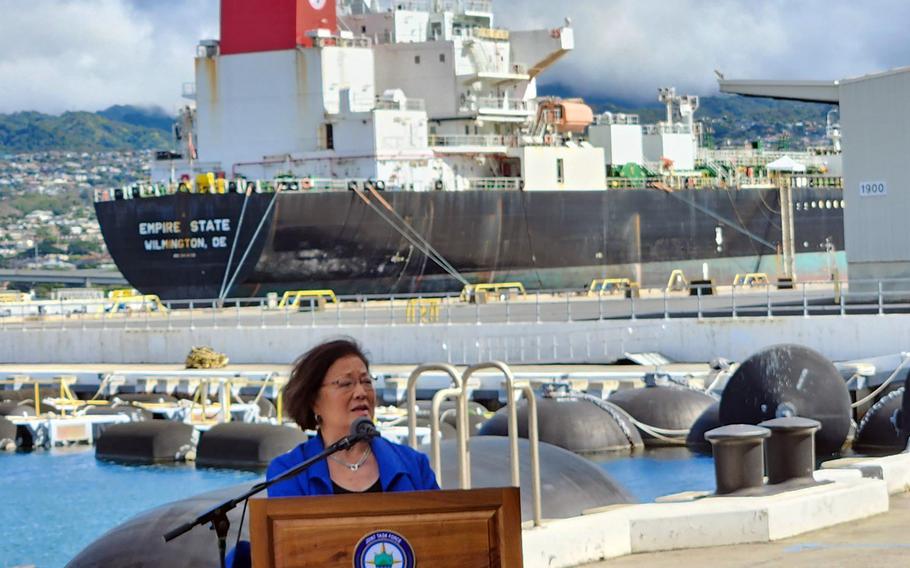
Sen. Mazie Hirono, R-Hawaii, speaks at Joint Base Pearl Harbor-Hickam, Friday, Oct. 13, 2023, flanked by the merchant tanker Empire State, which will be used to carry fuel being emptied from the Red Hill Bulk Fuel Storage Facility. (Wyatt Olson/Stars and Stripes)
JOINT BASE PEARL HARBOR-HICKAM, Hawaii — Hawaii state and federal officials gathered on a Pearl Harbor pier Friday to speak to reporters about what some described as a milestone: defueling the Red Hill Bulk Storage Facility starting Monday.
The speaker who best captured the public’s sentiment on the facility’s drainage and eventual closure, however, was the deputy director of environmental health for the Hawaii Department of Health.
“Nearly two years ago, an unprecedented environmental disaster occurred in Hawaii,” said Kathleen Ho, referring to a fuel leak in late 2021 that contaminated a Navy water distribution system used by tens of thousands of residents.
“The people of Hawaii came together to call for the defueling and closure of Red Hill,” she said. “Now defueling is about to begin. For many people in our community, this milestone is more of a source of relief than a cause for celebration.”
Draining the 104 million gallons of fuel in the World War II-era underground tanks will take about three months. Fuel will drain via gravity through roughly 3 miles of pipes that end at a fueling pier on the joint base.
There, the fuel will be loaded onto tanker ships and relocated to San Diego, Subic Bay in the Philippines, the Port of Singapore and a pair of fuel depots in Hawaii.
Vice Adm. John Wade, who heads Joint Task Force-Red Hill, the Defense Department entity tasked with emptying the tanks, told reporters that “99.9%” of the fuel will drain via that initial gravity system.
“When that phase completes, then we must get after what’s called residual fuel,” he said. Residual fuel can’t be drained using gravity because it has accumulated in low points and bends in pipes.
The task force estimates the system will hold about 70,000 gallons of residual fuel, Wade said.
“Once that is complete, which we estimate will be in the early spring, then, at some point, the joint task force will transition to our critical partners, the Navy, and the Navy has the responsibility for closing the facility,” he said.
The Navy will have to remove roughly 3,000 gallons of liquid-solid “sludge” in the tanks, which can only be done at the time the piping is actually disassembled, Wade said.
Hawaii Gov. Josh Green told reporters that he was confident the defueling would be done safely and successfully given the planning carried out by the Defense Department, Hawaii Department of Health and the U.S. Environmental Protection Agency.
“Furthermore, our first responders and community leaders are well trained for any emergency that may come so they can continue to work closely with [the task force], Navy Region Hawaii, Joint Base Pearl Harbor-Hickam and the federal fire department,” he said.
Green emphasized that the defueling was “just the first course, the first step” in setting right all that went wrong with the fuel facility, which Defense Secretary Lloyd Austin ordered closed in March 2022.
“Three things: We’re going to drain Red Hill; we will close the facility permanently; and we will remediate the aquifer,” Green said.